BANFF – A proposal to demolish abed and breakfast inn made up of historic cabins and build a fully accessible two-storey building didn’t get off the ground amid concerns for intensification of commercial development in residential neighbourhoods.
The Municipal Planning Commission concluded that wheelchair-bound J.P. Middleton’s proposal to demolish his Beaver Street Cabins and increase the commercial accommodation units from six to 10 in a new building doesn’t conform to legislation.
MPC commissioners said they believe there is sufficient flexibility in the land use bylaw to allow minor modifications of existing B&B inns, however drew the distinction between modifications and expansions and outright removal and replacement of buildings.
“It is clear that the proposed intensification of use of the land is commercial in nature and it is also clear that the land use of the RCM district is residential,” said Commissioner Bryan Howie, who is Parks Canada’s representative on MPC, Wednesday (April 10).
“By completely demolishing the existing B&B inn and erecting new buildings this is considered new; and increasing the number of rooms and gross floor area is also considered new.”
This particular case is expected to guide any future consideration for demolition and redevelopment of the seven other existing B&B inns in Banff, which are primarily located in older residential buildings.
For Middleton, however, this decision is extremely personal and disappointing. Now wheelchair bound following a spinal injury after a skiing accident at Mount Norquay last year, he has been an advocate for accessible accommodation in Banff.
Middleton said he respects MPC’s decision and will come up with new development plans for the property, but it will take some thinking and time.
"We’re disappointed with the decision, but we remain committed to the goal of providing barrier-free accommodation in Banff National Park,” he said.
The James Thomson Residence and Cabins were built over a 35-year period between 1914 and 1950. Today there are four buildings and two sheds left on the site, which have varying degrees of historical integrity remaining. The property is on the municipality’s heritage inventory.
Middleton said the cabins lack accessibility and require modernization to meet the needs of people with disabilities, noting simple retrofits aren’t possible in some of the cabins because of their small size.
He said one idea is to take the square footage of some of the smaller cabins and incorporate that into a separate fully accessible building.
“We would keep it on a smaller scale and work within the decision they’ve given us … it’s limited, but doable, I think,” he said.
The Eleanor Luxton Historical Foundation also weighed in on the case.
The foundation owns properties from the corner of Beaver Street and Caribou Street to Beaver Lodge at 212 Beaver St., including the Luxton Home at 206, an accredited museum and the oldest home in Banff Tanglewood at 208.
Bill Luxton, the foundation’s president, wrote to MPC to say the foundation is not opposed to the intent of Middleton’s proposal, noting properties must be financially viable in order to protect built heritage.
“We would support a plan that would enable the current historic Beaver Cabins to be sustainable. We have faced similar problems with our properties,” said Luxton, noting maintaining historic properties is expensive.
“We have recently developed a plan that we believe will provide long-term sustainability for the Luxton properties. We are looking forward to communicating our plans with the Banff community in the next few weeks.”
There are currently eight B&B inns in Banff. These developments are different than B&B homes, in that they only exist because they were authorized by Parks Canada prior to municipal incorporation in 1990.
Aside from commercial growth management and the imbalance between commercial and residential development at the time, how to better regulate the proliferation of B&Bs was one of the single biggest issues.




